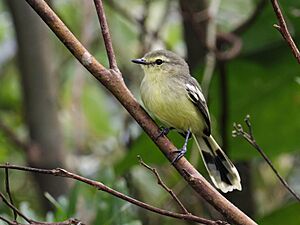Lesser wagtail-tyrant facts for kids
Quick facts for kids Lesser wagtail-tyrant |
|
|---|---|
 |
|
| Lesser wagtail-tyrant | |
| Conservation status | |
| Scientific classification | |
| Genus: |
Stigmatura
|
| Species: |
napensis
|
 |
|
The lesser wagtail-tyrant (Stigmatura napensis) is a small bird from South America. It belongs to the Tyrannidae family, which includes many types of flycatchers. These little birds are known for their active movements and unique calls.
Contents
Where Do Lesser Wagtail-Tyrants Live?
Lesser wagtail-tyrants live in a special kind of place. They are mostly found on islands in the Amazon River. These islands are often new and have lots of fresh, fast-growing plants.
Their Favorite Homes
These birds love areas with new plant growth. This includes thick grasses, bushes, and young trees. You can also find them on new beaches. These beaches are usually on islands in big, fast-flowing rivers. They like places with tall grass and young tessaria trees.
What Do Lesser Wagtail-Tyrants Look Like?
Lesser wagtail-tyrants are medium-sized birds. They have grey feathers on their backs and bright yellow feathers on their bellies.
Key Features
- They have a long tail that is white and brown.
- Their wings are a mix of white and dark feathers.
- They have a thin, pale-yellow stripe above their eyes.
- A dark line runs through their eyes.
- Their beak is short and black.
- Their legs are also short and dark.
What Do Lesser Wagtail-Tyrants Eat?
Lesser wagtail-tyrants love to eat insects. They often hunt for food in pairs or small family groups.
How They Hunt
These birds are very active hunters. They move quickly, pausing only for short moments. They often hold their tail high, pointing it upwards. Sometimes, they even go down to the ground to find insects. When they fan their tail, you can see its broad white tips and yellowish base. Their wings might droop a little as they hunt. Scientists believe they eat mostly insects.
Sounds and Songs
Lesser wagtail-tyrants are quite noisy birds. Their calls and songs make it easy to know they are around.
Their Unique Calls
They have a fast song that they often sing together. One common call sounds like a soft whistle, "wheeert?" or "weeeéé." They also make a harsh, rattling sound. It's like the sound of a ball bouncing! Different groups of these birds might have slightly different versions of these calls. For example, some groups have a rattling sound that speeds up with longer notes at the start.


